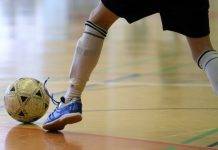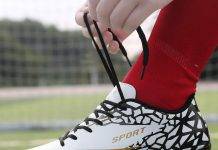In the fascinating world of soccer, one question that continually sparks debate is whether tight or loose cleats are better for the game. As players, we find ourselves pondering over the intricate relationship between our footwear and our performance on the field. Whether we favor the snug fit that offers precision and control, or the looser feel that grants freedom of movement, the battle between tight and loose cleats is as old as the sport itself. Join us as we embark on a journey to uncover the truth behind this eternal dilemma and discover which type of cleats reign supreme in the world of soccer.
Benefits of Tight Cleats
Review contents
Improved stability
Tight cleats provide a snug fit around the foot, which can greatly enhance stability on the field. With a secure and close-fitting cleat, the foot is less likely to shift inside the shoe during quick movements, ensuring better balance and stability. This can be particularly advantageous when making sharp turns, sprinting, or changing directions on the soccer field. The added stability from tight cleats can give players more confidence in their movements and allow them to perform at their best.
Enhanced control
One of the key benefits of tight cleats is the improved control they offer. By hugging the foot tightly, these cleats allow for a greater level of sensitivity and touch with the ball. This can be crucial when it comes to dribbling, passing, and shooting accurately. With a closer connection between the foot and the cleat, players can have a better sense of control over the ball, making precise movements and adjustments more seamless.
Reduced risk of injuries
Tight cleats can also help reduce the risk of certain injuries on the soccer field. By keeping the foot securely in place, tight-fitting cleats can minimize the chances of sprained ankles and other foot-related injuries. The stability and support provided by a tight fit can help prevent the foot from rolling or twisting excessively, especially during challenging maneuvers or tackles. This can be particularly beneficial for players who have a history of ankle instability or are prone to ankle injuries.
Drawbacks of Tight Cleats
Discomfort and blisters
While tight cleats offer advantages in terms of stability and control, they can also lead to discomfort and the formation of painful blisters. A snug fit may cause friction between the foot and the shoe, leading to rubbing and irritation. This can result in blisters, which can be both painful and potentially affect performance. It is important to find a balance between a tight fit for stability and control, and ensuring adequate comfort to prevent discomfort and blisters.
Restricted circulation
Tight cleats can also restrict blood circulation in the feet. When a cleat is too tight, it can impede proper blood flow, which can result in discomfort, numbness, or even foot cramps. Restricted blood circulation can also impact overall performance, as the lack of proper oxygen supply can lead to decreased muscle function and slower recovery. It is crucial to prioritize foot health and ensure adequate circulation by finding the right balance in cleat fit.
Limited flexibility
Another drawback of tight cleats is the potential limitation in foot flexibility. A tight fit can restrict the natural movement of the foot, making it more challenging to flex, stretch, or bend the feet as needed during play. Limited flexibility can hinder a player’s ability to execute certain techniques or maneuvers effectively. It is important to assess the trade-off between tightness and flexibility, considering the specific playing style and personal preferences.
This image is property of thefrisky.com.
Advantages of Loose Cleats
Increased comfort
Loose cleats provide a more relaxed fit around the foot, offering increased comfort during gameplay. With a bit more space in the shoe, players may experience less pressure and rubbing, resulting in a more enjoyable playing experience. Comfortable cleats can contribute to enhanced focus and performance, allowing players to fully concentrate on the game without distractions or discomfort.
Improved blood flow
One of the significant advantages of wearing loose cleats is the improved blood flow they allow. With a looser fit, the feet have more room to breathe and proper circulation is less likely to be compromised. Unimpeded blood flow ensures optimal oxygen and nutrient supply to the muscles, which can contribute to better endurance and overall performance on the field. By promoting healthy blood circulation, loose cleats can help minimize the risk of muscle fatigue and cramps.
Better flexibility
Loose-fitting cleats offer greater flexibility for the foot. With a little more room to move and bend, players can execute a wider range of movements without feeling restricted. This enhanced flexibility can be particularly advantageous for players who rely on quick changes in direction or agile footwork during the game. The ability to freely flex and bend the feet can contribute to improved agility, which is essential in soccer.
Disadvantages of Loose Cleats
Reduced stability
One of the main drawbacks of loose cleats is the reduced stability they provide. With a looser fit, there is a higher chance of the foot moving inside the shoe, potentially leading to instability and a loss of balance on the field. This can be detrimental in situations where quick and precise movements are necessary, such as when tackling opponents or making sharp turns. Players who prioritize stability may need to find alternative ways, such as additional ankle supports, to compensate for the lack of stability in loose cleats.
Decreased control
Loose cleats can also result in decreased control over the ball. With a less secure connection between the foot and the cleat, players may experience a reduced level of sensitivity and touch when handling the ball. This can affect the accuracy of passes, shots, and overall ball control. For players who prioritize precise control over the ball, a tighter cleat fit may be more beneficial.
Higher risk of injuries
Wearing loose cleats can potentially increase the risk of certain injuries on the soccer field. With a less secure fit, the foot is more prone to rolling or twisting, leading to potential sprains or other foot-related injuries. The lack of stability and support in loose cleats can make it harder to maintain proper foot position, especially during high-intensity plays or sudden changes in direction. Players who opt for loose cleats should be particularly cautious and consider additional measures to prevent foot and ankle injuries.
This image is property of upper90football.com.
Considerations for Selecting Cleat Fit
Playing surface
When selecting the right cleat fit, it is essential to consider the playing surface. Different surfaces, such as grass, artificial turf, or indoor courts, require varying levels of traction and stability. For instance, on wet or muddy grass fields, a tighter cleat fit may provide better grip and prevent slipping. On the other hand, on artificial turf or harder surfaces, a looser cleat fit may be more suitable to absorb impact and minimize stress on the feet.
Foot type
Every player has a unique foot shape and structure, which should be taken into consideration when choosing the appropriate cleat fit. Some players may have wider feet or higher arches, requiring a slightly looser fit to ensure comfort and prevent discomfort or foot-related issues. Conversely, players with narrow feet may benefit from a tighter fit to enhance stability and control. Understanding one’s foot type and finding cleats that accommodate it can greatly contribute to overall performance and comfort on the field.
Playing style
Individual playing style should also be considered when determining the ideal cleat fit. Players who prioritize speed and quick movements may lean towards a tighter cleat fit to maximize stability and control. On the other hand, players who rely more on agility and intricate footwork might prefer a slightly looser fit to enhance flexibility and freedom of movement. Adjusting the cleat fit according to one’s playing style can help optimize performance and comfort.
Effect of Cleat Fit on Performance
Speed and agility
Cleat fit can have a significant impact on speed and agility on the soccer field. A tight fit can provide the necessary stability and traction for explosive movements, allowing players to accelerate quickly and maintain control during high-speed runs. On the other hand, a looser cleat fit can enhance agility by allowing for greater flexibility and ease of movement. The choice between tight and loose cleats should be made in consideration of the specific requirements of a player’s speed and agility-focused playing style.
Ball handling
The way the cleat fits on the foot can greatly affect ball handling skills. A tight cleat fit can provide improved touch and sensitivity to the ball, enabling better control and accuracy when dribbling, passing, or shooting. The increased stability from a tight fit can also contribute to a stronger connection between the foot and the ball, allowing for more precise ball manipulation. However, some players may find that a slightly looser cleat fit allows for more creativity and finesse in their ball handling technique. Experimentation is key to finding the right balance between comfort and control.
Overall game performance
The overall performance of a player can be influenced by the fit of their cleats. A well-fitted pair of cleats can contribute to improved stability, enhanced control, and better agility. These factors, in turn, can positively impact a player’s decision-making, positioning, and execution of various soccer techniques. Conversely, an ill-fitting or uncomfortable pair of cleats can be a distraction and hinder a player’s ability to perform at their best. Finding the right cleat fit is crucial in maximizing overall game performance.
This image is property of brand.assets.adidas.com.
Tips for Choosing the Right Cleat Fit
Try different sizes
It is highly recommended to try on different cleat sizes to find the best fit. Sizes can vary between different brands and models, so relying solely on a specific shoe size may not guarantee an ideal fit. Trying various sizes allows players to assess the level of comfort, stability, and control offered by different fits. Taking the time to test different sizes before making a purchase can ensure a better overall cleat fit.
Consider adjustable cleats
Some cleat models offer adjustable features, such as laces or straps, which allow for a more personalized fit. These adjustable cleats can provide the best of both worlds, as players can fine-tune the fit according to their preferences and specific foot shape. Adjustable cleats can be a suitable option for players who struggle to find a cleat that fits perfectly right off the shelf.
Consult with a professional
For players who are unsure about the right cleat fit for their specific needs, consulting with a professional, such as a sports podiatrist or a skilled soccer coach, can provide valuable insights and guidance. These professionals can offer expert advice based on their experience and knowledge, taking into consideration factors such as foot type, playing style, and individual goals. Seeking professional assistance can help players make an informed decision and find the most suitable cleat fit.
Proper Care and Maintenance
Cleaning and drying
Taking care of cleats is essential to ensure their longevity and performance. After each use, it is important to remove any dirt or debris from the cleats. Using a soft brush or cloth, gently scrub away any accumulated mud or grass. Allow the cleats to dry naturally in a well-ventilated area, avoiding direct sunlight or heat sources, which can damage the material. Regular cleaning and drying can help prevent odor, maintain the cleats’ structure, and ensure optimal performance.
Replacing worn-out cleats
Cleats are subjected to significant wear and tear during soccer games and practices. As the studs or sole of the cleats wear down, their effectiveness and performance may diminish. It is important to inspect the condition of the cleats regularly and replace them when necessary. Worn-out cleats can lead to reduced traction, stability, and overall game performance. Keeping a spare pair of cleats and monitoring their condition can help ensure that players consistently have well-maintained footwear for optimal performance.
Breaking in new cleats
New cleats may initially feel tight or stiff, and it is important to properly break them in for optimal comfort and performance. To break in new cleats, it is recommended to wear them for short periods during practice sessions or low-intensity activities. Gradually increase the duration and intensity of wear over time, allowing the cleats to mold to the shape of the foot. This process can help minimize discomfort and prevent blisters when playing in new cleats for extended periods.
This image is property of i.ytimg.com.
Expert Opinions
Professional players’ preferences
Professional soccer players often have specific preferences when it comes to cleat fit. Some may prefer a tighter fit for maximum stability and control, while others may opt for a slightly looser fit to prioritize comfort and flexibility. These preferences can vary depending on individual playing styles, foot types, and personal experiences. Observing the cleat choices of professional players can provide insights into the impact of different fit options on performance.
The views of soccer coaches
Soccer coaches, with their extensive knowledge and experience, can offer valuable perspectives on cleat fit. Many coaches emphasize the importance of finding the right balance between tightness and comfort. They often recommend that players prioritize stability and control to enhance performance while ensuring adequate comfort to prevent discomfort or injuries. Coaches’ insights can help players make informed decisions when selecting appropriate cleat fit.
Sports science research findings
Sports science research plays a vital role in understanding the impact of cleat fit on performance and injury prevention. Studies have examined various aspects, such as the effect of different cleat types on traction and stability, the relationship between cleat fit and foot-related injuries, and the influence of cleat fit on ball handling techniques. The findings from these scientific studies provide evidence-based guidance for players seeking to optimize their cleat fit for improved performance and safety.
Conclusion
In conclusion, the choice between tight and loose cleats in soccer depends on individual preferences, playing style, and specific needs. Tight cleats offer enhanced stability, improved control, and reduced risk of injuries. However, they may bring about discomfort, restricted circulation, and limited flexibility. On the other hand, loose cleats provide increased comfort, improved blood flow, and better flexibility, but they may result in reduced stability, decreased control, and higher injury risks.
When considering cleat fit, factors such as playing surface, foot type, and playing style should be taken into account. Cleat fit has a significant impact on performance, influencing speed, agility, ball handling, and overall game performance. To choose the right cleat fit, it is recommended to try different sizes, consider adjustable cleats, and seek professional guidance when needed.
Proper care and maintenance of cleats, including cleaning and drying, replacing worn-out cleats, and breaking in new cleats, are essential for their longevity and performance. Expert opinions, including those of professional players, soccer coaches, and sports science research findings, provide valuable insights into the impact of cleat fit on performance and injury prevention.
In the end, finding the perfect cleat fit requires a balance between stability, control, comfort, and flexibility. By understanding the benefits, drawbacks, considerations, and tips outlined in this article, players can make informed decisions when selecting and maintaining their cleats, ultimately enhancing their soccer performance on the field.
This image is property of thefrisky.com.










































